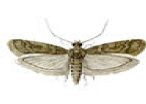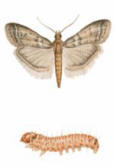
The adult tobacco moth is a small, gray moth about 3/8 of an inch long, with a 5/8 inch wingspread.
- This cosmopolitan moth is a light greyish brown with two light bands extending across each forewing. It is similar in size to the Mediterranean flour moth.
- The adult tobacco moth is a small, gray moth about three eighths inch long with a five eighths inch
- 12mm wingspan; upper forewing: well defined, rather sinuate outer band on grey-buff background. Banded pale grey or buff wings, antennae held close to the insects back.
- 12mm wingspan; upper forewing: well defined, rather sinuate outer band on grey-buff background
- 12mm wingspan; upper forewing: well defined, rather sinuate outer band on grey-buff background. Banded pale grey or buff wings, antennae held close to the insects with a wingspan of 10—16mm. Very similar to the Tropical warehouse moth.
- Larva — very similar to the Tropical warehouse moth.
- This moth will feed on tobacco, chocolate, cereals and seeds. Widely distributed throughout temperate regions, the most common stored product pest moth in the U.K., although uncommon in the northern parts of the U.K. It is rarely imported except on products from other temperate areas
- Widely distributed throughout temperate regions, the most common pest moth in the U.K., although uncommon in the northern parts of the U.K. It is rarely imported except on products from other temperate areas.
- A serious pest of cocoa beans, chocolate confectionery, dried fruit and nuts.

Eggs - Up to 270 eggs laid on or near produce.
Larvae - Move to and over produce, feeding and spinning threads that can form webs.
Pupae - Form in cracks nearby.
Adults - Non feeding; short lived; fly particularly at dawn and dusk toward top or roof of store
Cycle: Females lay eggs in and around potential food sources.
- Damage caused by the larvae may be considerable. Most stored food commodities will be attacked, although white flour is not attractive to the larvae
- Tobacco moths and the cigarette beetle commonly attack tobacco that is stored on the farm, he says. “The tobacco moth is the most serious of these insects. The larvae, which cause all of the damage, are pinkish to yellow to off-white caterpillars about one half inch long. They burrow into and form ragged holes in the cured leaves.
- Entire leaves may be consumed except for the midrib and large veins. The larvae also deposit webbing and faecal pellets on the infested tobacco.
A major pest of warehouses and, more recently, retail premises. This species will infest cereals, fruit, shelled nuts, cocoa beans, fish, spices and tobacco. In the case of tobacco, "sweet" varieties are preferred and entire interveinal leaf areas may be destroyed. Moth infestations are especially serious where wheat and flour are stored in bulk, although they seldom infest goods that are stored in silos
 prevention,
he adds, is sanitation.
prevention,
he adds, is sanitation.“Before tobacco is placed in storage, prepare a clean storage area. Clean out and burn all tobacco and debris from the storage area. Plant trash remaining in the storage area might harbour insects that can move to the tobacco.”
To help prevent tobacco moth infestations, Moore recommends treating with Bacillus thuringiensis (Bt). “Apply a fine spray to loose tobacco as it is being sheeted. It's very hard to repack sheets and get the good coverage required. One suggestion might be to apply Bt as a fine mist as the tobacco is sent through a conditioning cylinder or tumbler.”
Stored tobacco should be checked every two to four weeks during the fall and winter for signs of insects and for new damage, he says. If tobacco moths are found, they should be treated with Bt.
“Treating the outside
of piles and/or the sheets probably will not control an established
infestation. Piles must be taken apart and the tobacco treated as loose
leaves before re-sheeting. Sheets also may be treated.”
Malathion, says Moore, is labelled for the treatment of storage
facilities as a residual spray for the control of cigarette beetles.
There are no labelled cigarette beetle preventive insecticides for
applying directly to tobacco.